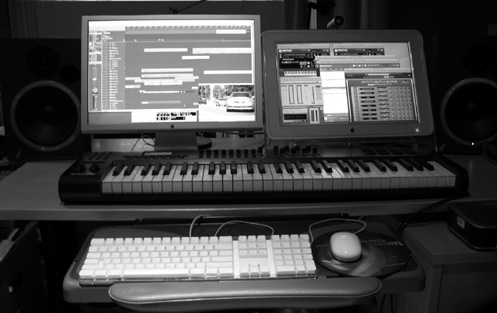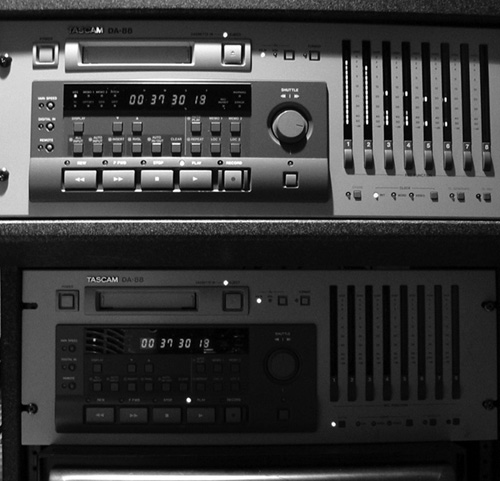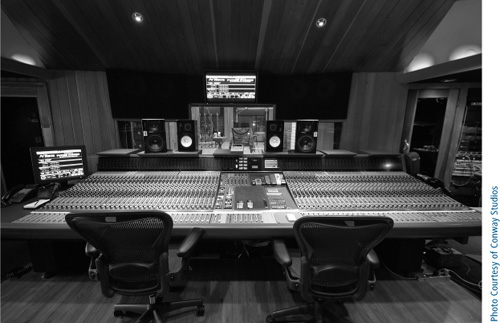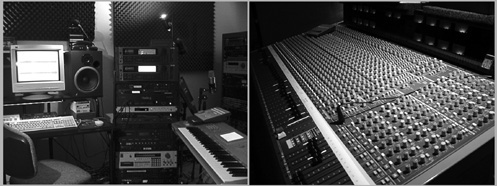THE PROCESS OF WORKING ON the music for your music video may vary, depending on whether you want to use an existing track of music or record a new piece specifically for the video. And note that I’m talking about your music—original music—a song or instrumental that you or someone in your band has created. If you are planning to make a music video out of someone else’s work, it might be a useful exercise or practice session for the real deal. But you won’t be able to post it. You won’t be able to air it—unless, of course, you’re planning on being sued (or you get written permission from the artist). Enough said.
In almost all cases, the music is the roadmap for the visual. You are likely going to illustrate whatever the music (and more than likely, I’m talking about lyrics here) is doing at any given point. This does not mean you are confined to producing a literal translation of your lyrics into videotape. You can, after all, use abstract imagery or special effects to get the right mood across in certain cases. Still, it is the music that is driving everything else, including instrumental music that doesn’t include lyrics. At the very least, the music video should evoke a mood or emotions—reactions that are strong enough to make the viewers remember the song and/or the artist. The music is the master of the project.
As you can imagine, all of these considerations will involve some thinking and some planning. As a general rule, you wouldn’t grab one of your songs, go outside with a video camera, and shoot an entire music video from scratch. And yes, although rules are meant to be broken (by those who understand them), I wouldn’t recommend the unplanned, random, stream-of-consciousness approach. (The exception to this rule applies to millionaires who have lots of free time.)
If you’re going to use an existing track for your music video, you may want to skip ahead to Chapter 2, “Mixing Considerations”. And if you are planning to record a new track, the following sections may prove to be useful to you.
How will you go about recording a new track? Assuming you’ve got the right kind of song in mind, you still have choices about the recording process itself. You may choose to use one of the following:
Digital Audio Workstation, or DAW
Multitrack recorder, either analog or digital
A professional recording studio
All of these are viable choices, and the one you use depends on your particular situation.
Because it’s 2010, most people who use the DIY (do-it-yourself) method will likely opt to use a Digital Audio Workstation (DAW). (I could say DIY with a DAW, but I won’t.) This is because of several reasons; among them are that the majority of songwriters, composers, and music hobbyists have DAWs in their own homes or project studios. Another very good reason is that this particular group of people might also have desktop video software, which would make the whole prospect of creating a music video very compelling; all of it could be accomplished using a single desktop computer. Today’s desktop audio systems have reduced an entire room of recording equipment to a sleek desktop system, as shown in Figures 1.1 and 1.2.

Figure 1.2. Today’s typical DAW (Digital Audio Workstation) reduces an entire studio to a compact desktop system.
Note
Stop for a second and give notice to this amazing fact. You can make a complete music video, at home, using a sequencer and desktop video software. You can then make multiple DVDs to distribute or video files to post on the Internet. All of this can be done with prosumer computer setups that are more powerful than the computers that took us to the moon! This is certainly something worth noting, in a stop-and-smell-the-roses kind of way. Okay, let’s move on.
If you choose the DIY method, a DAW makes a lot of sense because you can:
Be in complete control of the music production.
Choose to change the music later on if needed.
Make sure that all of the technical considerations (file types, sync issues, and so on) are handled correctly.
Edit the video yourself and make changes late in the process if desired.
Have greater control even if you choose to use a professional editor.
Having greater control when using outside resources really applies to any and all outside resources you might use. When you have a desktop workstation, especially one equipped with both music sequencing and desktop video software, you can get into the heart of the project during multiple iterations or versions of the music video as it progresses. You can use the desktop software to try things out on your own, or to examine first-hand how the editor pieced together a particular section. If you created the music tracks on your sequencer, you can make extremely precise edits to the music if it should prove necessary. You can experiment with sound effects and video effects without altering the original file—until you’re confident that you want to use them.
A multitrack recorder can mean analog machines, such as those manufactured by Studer or Fostex (see Figure 1.3). A multitrack recorder can also mean digital multitrack recorders such as those from Tascam or Alesis (see Figure 1.4). Although not as commonly used as a DAW, multitracks are still around, and you, in fact, might want to choose this method of recording.

Figure 1.3. A multitrack analog machine will require razor-blade editing if you need to make changes later.

Figure 1.4. A digital multitrack has some benefits over analog, but still does not provide the flexibility of a DAW.
The good news is that you can make a music video based on a track or song created with a multitrack recorder.
The bad news is that some of the key advantages of using a DAW go away. You will have a difficult—sometimes impossible—time trying to make changes to the music later in the process. Random access digital audio and video make this relatively easy. Making changes using linear machines—analog or digital—usually will require redoing tracks that were recorded early on, not to mention re-mixing and re-mastering the final stereo mix. And, if you do make changes that ultimately do not work, you have to go back to the drawing board yet again. All of this can make for a difficult process.
Warning
By far, the biggest disadvantage of not using a DAW is that there is no Undo button! Ouch! Do you remember what life was like before that one little feature shown in Figure 1.5? If you’ve been using computer-based systems for any amount of time, the ability to undo is second nature. It’s expected, commonplace, and matter-of-fact. When you lose that capability, it can be quite a shock, especially when it comes to creating music videos.
A multitrack recorder can be your choice for creating the music for a music video. In reality, it will have to be mixed to a two-track stereo mix, which can be analog linear or random access digital. But to make actual changes (other than removing an entire verse or chorus or intro, and so on) will require you to go back to the original multitrack version, and that’s where the difficulties reside. A DAW definitely wins out over the multitrack in most scenarios.
Perhaps you’ve already determined that you want to use a professional recording studio to create the music tracks for your video.
There are certainly advantages to using a professional studio when:
You want to record a band or ensemble live and the studio is equipped for it.
The studio has great gear, a good reputation, and an engineer you can work with.
You are using an outside producer and he has an established relationship with the studio.
You have a sizeable budget (or a rich uncle).
Of these possible advantages, the first one is likely the strongest. If you have your own project studio but want to record bass, drums, guitars, keyboards, and vocalists—live—then a professional recording studio will provide the right environment for that.
But there might be disadvantages as well (similar to the ones mentioned in the previous multitrack section), if the studio does not use Pro Tools or Logic or some other digital-based, random-access recording method. If the studio is using linear (or even digital) analog machines, you will have a much greater challenge if you need to make changes later. Even at that, changes required after the original mixdown session will require booking more studio time—which is a reminder of another disadvantage: cost. It’s one thing to work in your own project studio at any time you want, and another to be paying hourly rates as those hours start to accumulate. I know this from experience—both as a buyer of studio time and as a former studio owner.
You would also need to ensure that the studio has some sort of sync-to-video setup, so that whatever changes you are making later in the game are guaranteed to work. Leaving things up to chance is never a good idea, especially in critical timing situations that are measured in frames or milliseconds.
The advantages of random access digital systems, meaning DAWs, make them clear winners over the old school method of linear recording, whether analog or digital. Think of it this way: Would you prefer to use a word processer or a typewriter to create a document? The differences are that dramatic.
First, consider the number of tracks you want to end up with. If you were to take that statement literally, the answer would be two—a stereo mix consisting of a left and a right channel. No matter which method you use to record—analog or digital, DAW or studio—you will ultimately end up with a two-track mix. The process of how you get to that final product may be different.
You may be in a band and so you choose to use a professional studio, enabling you to fit everyone in the room and to record live or simultaneously. You may be a singer/songwriter who plays acoustic guitar—and so you choose to record live to capture the feeling or emotion of a live recording. You can record live to a two-track (that is, stereo) recorder or to a multitrack recorder.
Some artists are studio artists—meaning they don’t perform well in live situations, but they know how to take advantage of all the tools that a studio has to offer. This artist may choose to lay down individual tracks, one at a time, or in concert with a few other musicians.
The important point to remember is that you are not confined to an either-or situation. Even a live recording can be sweetened, which may mean adding a few extra tracks, or cleaning up the existing tracks, or both. The important point to keep in mind is that the recording you’re doing will be the foundation for a music video. For example, if you record your band in order to capture that live feeling and adding strings fits well with your particular song, that’s fine. But unless you will be using cutaway shots, make sure your keyboard player—the one who plays the strings on his or her synthesizer—shows up to the video shoot. So the main issue here is not whether you have to choose recording live or overdubbing or both. The main issues are looking ahead at the video shoot, and planning ahead, which will make a huge difference later.
If you don’t have your own studio, finding a professional one should not be too much of a problem in this day and age. Every major (and minor) city has recording facilities of some sort. What can vary is the type of studio. At the high end you will find studios that may have 24-track (or more) capabilities, including a Pro Tools setup, an array of instruments, and a nice lounge that includes a spa. This will be one price. (I don’t know whether Conway Studios, shown if Figure 1.6, has a spa or not, but it is one of the best studios in L.A.) Another price may apply to a studio that portrays itself as professional but really exists in the owner’s garage and causes you to take breaks every time a jet aircraft flies overhead to land at the nearby airport. You might be able to make a decent recording in this studio—in some amount of time. Just make sure that Studio B (the one in the garage) doesn’t charge the same prices as Studio A. You have every right to check out the studio beforehand to ensure that it meets your needs.

Figure 1.6. Conway Studios is one of L.A.’s best studios, offering traditional multitrack recording as well as Pro Tools systems.
A professional recording studio can offer a lot of bang for your buck—more gear, higher quality, and a professional engineer. If you have the bucks and can afford it, then a professional studio may be the right choice for you. But remember, the editing flexibility that a DAW offers you is hard to beat, and even pro studios don’t have an Undo button for every possible situation.

